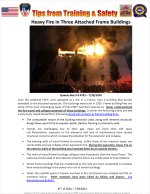You are using an out of date browser. It may not display this or other websites correctly.
You should upgrade or use an alternative browser.
You should upgrade or use an alternative browser.
FDNY Training Tips 2024-71: Heavy Fire in 3 Attached Frame Buildings
- Thread starter Capttomo
- Start date
- Joined
- Jul 20, 2022
- Messages
- 437
Brothers and sisters, these FDNY Tips form Training & Safety are widely published with the intent of saving firefighter lives and ensuring that current thinking firefighters learn from what has happened and from experts that know what can happen. My friend, now retired Deputy Chief Jay Jonas also had his Div. 7 Health and Safety Newsletters. All this is truly available online use them. With myself with over 50 years of firefighting experience including 30+ years with the FDNY have learned and continue to learn new ideas and tactics from these publications,
I you ever stop learning you are not a safe firefighter. Captain Bob Rainey FDNY Engine 26 retired
I you ever stop learning you are not a safe firefighter. Captain Bob Rainey FDNY Engine 26 retired
This was a row frame and not a non-fire proof MD, so such labelling would be inappropriate. But if it were a non-fire proof MD, it would be a NLT.Wouldn't this be considered a Old Law Tenement or do I have my years mixed up?
Old Law: - 1901
New Law: 1901 - 1929
Apartment House: 1929 -
Last edited:
Old law was pre-1901.This was a row frame and not a non-fire proof MD, so such labelling would be inappropriate. But if it were a non-fire proof MD, it would be a NLT.
Old Law: 1901 - 1916
New Law: 1916 - 1929
Apartment House: 1929 -
New Law was 1901-1929
The Tenement House Act of 1901 was passed in April, so 1901 may have had some Old Law buildings constructed before then.
That's on me, not paying attention while at the pool on vacation.Old law was pre-1901.
New Law was 1901-1929
The Tenement House Act of 1901 was passed in April, so 1901 may have had some Old Law buildings constructed before then.
- Joined
- Jul 20, 2022
- Messages
- 437
Tenements are Class 3 Wood and Joist construction normal with Brick exterior walls under the NYC Building Code. Row frames are all wood including the exterior walls this is class 5 Construction. The danger is that all the structural elements of the building are wood and therefore burn. So, the structural components that hold the building up are subject to rapid failure and collapse. ANY building at the end of a row of buildings OR that has had an attached building, that had been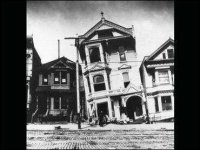
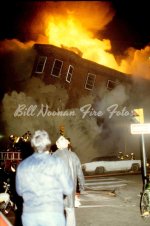
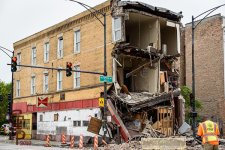
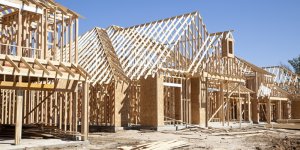
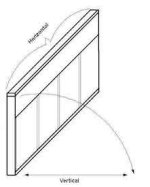
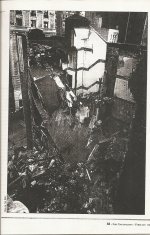 removed or destroyed is more likely to collapse, due to the loss of the strutting effect of the other building/s. The buildings help hold each other up, especially when burning, or compromised by other structural damage. Last Photo below is of a Collapse I worked at on W. 31 St, in Manhattan. The adjoining building had been removed, the brick side wall bulged and collapse when untrained workers tried to remove bricks from the (Now fully exposed side wall) and the entire brick mixed occupancy building collapsed killing the owner and some of the workers.
removed or destroyed is more likely to collapse, due to the loss of the strutting effect of the other building/s. The buildings help hold each other up, especially when burning, or compromised by other structural damage. Last Photo below is of a Collapse I worked at on W. 31 St, in Manhattan. The adjoining building had been removed, the brick side wall bulged and collapse when untrained workers tried to remove bricks from the (Now fully exposed side wall) and the entire brick mixed occupancy building collapsed killing the owner and some of the workers.
I was a Lieutenant in Tower Ladder 21 at the time. Captain Bob Rainey FDNY Engine 26





 removed or destroyed is more likely to collapse, due to the loss of the strutting effect of the other building/s. The buildings help hold each other up, especially when burning, or compromised by other structural damage. Last Photo below is of a Collapse I worked at on W. 31 St, in Manhattan. The adjoining building had been removed, the brick side wall bulged and collapse when untrained workers tried to remove bricks from the (Now fully exposed side wall) and the entire brick mixed occupancy building collapsed killing the owner and some of the workers.
removed or destroyed is more likely to collapse, due to the loss of the strutting effect of the other building/s. The buildings help hold each other up, especially when burning, or compromised by other structural damage. Last Photo below is of a Collapse I worked at on W. 31 St, in Manhattan. The adjoining building had been removed, the brick side wall bulged and collapse when untrained workers tried to remove bricks from the (Now fully exposed side wall) and the entire brick mixed occupancy building collapsed killing the owner and some of the workers.I was a Lieutenant in Tower Ladder 21 at the time. Captain Bob Rainey FDNY Engine 26
Last edited:
- Joined
- Jul 20, 2022
- Messages
- 437
I had typo in the entry above. which I have corrected. Heavy Timber Buildings are NYC Building Code Class 4. Lighter weight wood construction is NYC Building Code Class 5. Class 5 lightweight construction is NOT as strong, and the small dimensions of the flammable wood components can cause quick collapse of the building or section of the building. Tests on Lightweight Wood Mansard Roofs, often found on fast food buildings, "McDonalds, Pizza Hut, etc. " Have resulted in Roof Collapse in under < 4:00 minutes. Captain Bob Rainey FDNY engine 26 retired

